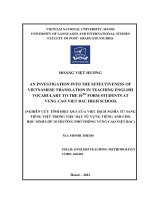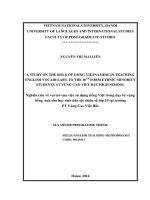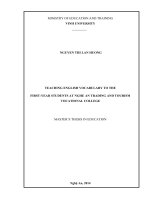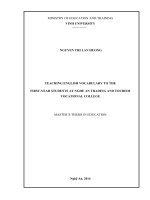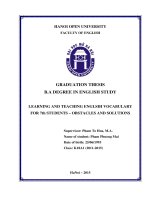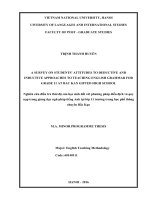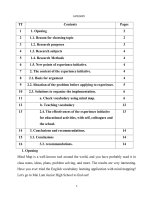Learning and teaching english vocabulary for 7th students obstacles and solutions
Bạn đang xem bản rút gọn của tài liệu. Xem và tải ngay bản đầy đủ của tài liệu tại đây (1.53 MB, 59 trang )
HANOI OPEN UNIVERSITY
FACULTY OF ENGLISH
GRADUATION THESIS
B.A DEGREE IN ENGLISH STUDY
LEARNING AND TEACHING ENGLSIH VOCABULARY
FOR 7th STUDENTS – OBSTACLES AND SOLUTIONS
Supervisor: Pham To Hoa, M.A.
Name of student: Pham Phuong Mai
Date of birth: 25/06/1993
Class: K18A1 (2011-2015)
HaNoi – 2015
HANOI OPEN UNIVERSITY
FACULTY OF ENGLISH
CODE: 25
GRADUATION THESIS
B.A DEGREE IN ENGLISH STUDY
LEARNING AND TEACHING ENGLSIH VOCABULARY
FOR 7th STUDENTS – OBSTACLES AND SOLUTIONS
Supervisor: Pham To Hoa, M.A.
Name of student: Pham Phuong Mai
Date of birth: 25/06/1993
Class: K18A1 (2011-2015)
HaNoi – 2015
Graduation Paper
DECLARATION
Title: Learning and teaching English vocabulary for 7th students –
obstacles and solutions.
I certify that no part of the above report has been copied or
reproduced by me from any others’ work without acknowledgement and that
the report is originally written by me under strict guidance of my supervisor
Hanoi, 2nd May, 2015
Student
Pham Phuong Mai
Pham Phuong Mai – K18A1 – (2011-2015)
Supervisor
Pham To Hoa, M.A
Graduation Paper
ACKNOWLEDGEMENT
I would like to express my deepest gratefulness to my supervisor, Mrs.
Pham To Hoa, who has provided the researcher with help, advices and
comments to complete this graduation thesis.
I am extremely grateful to the teachers at Faculty of English who
producing me with knowledge and basic skills to finish this thesis.
I take this opportunity to thank the teachers and students at Khuong
Thuong secondary school for their support and kind assistance during my
studying time.
I also would like to send my thanks to all my friends who have helped
me to develop ideas for the study.
Finally, my thanks must go to my family members whose continual
encouragement has been indispensable for the fulfillment of this challenging
work.
Hanoi, 2nd May, 2015
Student
Pham Phuong Mai
Pham Phuong Mai – K18A1 – (2011-2015)
Graduation Paper
TABLE OF CONTENTS
DECLARATION
ACKNOWLEDGEMENT
TABLE OF CONTENTS
PART A: INTRODUCTION .......................................................................... 1
1. Rational ..................................................................................................... 1
2. Aims of the study ...................................................................................... 2
3. Scope of the study..................................................................................... 2
4. Research questions ................................................................................... 2
5. Methods of the study ................................................................................ 3
6. Design of the study ................................................................................... 3
PART B: DEVELOPMENT........................................................................... 4
CHAPTER I: LITERATURE REVIEW ...................................................... 4
1.1. Theories on vocabulary ........................................................................ 4
1.1.1. The definitions of vocabulary ........................................................ 4
1.1.2. The important of teaching and learning English vocabulary ....... 5
1.2. Classification of vocabulary ................................................................. 5
1.2.1. According to the meaning .............................................................. 5
1.2.1.1. Notional words (Lexical words) ................................................. 6
1.2.1.2. Functional words (Grammatical words) .................................... 6
1.2.2. According to the concept of morphemes ...................................... 6
1.2.2.1. Simple words............................................................................... 7
1.2.2.2. Derived words ............................................................................. 7
1.2.2.3. Compound words ........................................................................ 7
Pham Phuong Mai – K18A1 – (2011-2015)
Graduation Paper
1.2.3. According to the function ............................................................... 7
1.2.4. According to the frequency of use ................................................. 8
1.3. What need to be taught in vocabulary teaching ................................ 9
1.3.1. Word form ...................................................................................... 9
1.3.2. Grammar ......................................................................................... 9
1.3.3. Collocation ..................................................................................... 10
1.3.4. Aspects of meaning ....................................................................... 11
1.3.4.1. Detonation ................................................................................ 11
1.3.4.2. Connotation .............................................................................. 11
1.3.4.3. Appropriateness ........................................................................ 11
1.3.4.4. Meaning relationships .............................................................. 12
1.3.5. Word formation ............................................................................ 13
1.4. Traditional teaching methods ............................................................ 14
1.4.1. Translation .................................................................................... 14
1.4.2. Visual technique ............................................................................ 14
1.4.3. Verbal technique ........................................................................... 15
1.5. Overview of vocabulary learning strategies. .................................... 16
CHAPTER II – THE STUDY ...................................................................... 17
2.1. Methodology ........................................................................................ 17
2.2. Objects of the study............................................................................. 17
2.2.1. 7th grade students and their background.................................... 17
2.2.2. Teachers and their teaching situation ......................................... 18
2.3. Data collection ..................................................................................... 18
2.3.1. The survey questionnaire ............................................................. 18
2.3.1.1. Purposes ................................................................................... 18
2.3.1.2. Description of survey questionnaire ......................................... 19
2.3.1.3. Data collection and analysis. ................................................... 20
Pham Phuong Mai – K18A1 – (2011-2015)
Graduation Paper
2.3.2. The observation ............................................................................. 26
2.3.2.1. Reasons for choosing the observation ...................................... 26
2.3.2.2. Description of the observation ................................................. 26
2.3.2.3. Results of the observation ......................................................... 27
2.4. Findings ................................................................................................ 28
2.4.1. The students’ difficulties .............................................................. 28
2.4.1.1. The meaning of words............................................................... 28
2.4.1.2. The pronunciation..................................................................... 28
2.4.1.3. The spelling ............................................................................... 29
2.4.1.4. The usage .................................................................................. 29
2.4.2. The teachers’ difficulties .............................................................. 30
2.4.2.1. The lack of time on teaching vocabulary.................................. 30
2.4.2.2. Obstacle in using computer ...................................................... 30
2.4.2.3. The lack of students’ attention .................................................. 30
2.4.3. Causes of the difficulties ............................................................... 31
2.4.3.1. Unsuitable method of teaching vocabulary .............................. 31
2.4.3.2. Unsuitable way to learn vocabulary......................................... 31
2.4.3.3. Other causes ............................................................................. 31
CHAPTER 3: RECOMMENDATION ....................................................... 33
3.1. Suggestion about effective ways of teaching English vocabulary... 33
3.1.1. Improving teachers’ teaching technique. ................................... 33
3.1.1.1. At the presentation stage .......................................................... 33
3.1.1.2. At the practice stage ................................................................. 37
3.1.1.3. At the production stage ............................................................. 41
3.1.2. Improving teachers’ computer skills .......................................... 44
3.2. The effective ways to improve vocabulary for students .................. 44
PART C: CONCLUSION............................................................................. 46
Pham Phuong Mai – K18A1 – (2011-2015)
Graduation Paper
REFERENCES .............................................................................................. 47
APPENDIX
LIST OF TABLES
Table 1: Importance of learning English vocabulary ................................ 20
Table 2: Interest of students in learning English vocabulary ................... 20
Table 3: Difficulties in learning English vocabulary ................................. 21
Table 4: Source(s) students use to learn vocabulary.................................. 21
Table 5: Things students do when learning English vocabulary .............. 22
Table 6: Ways of consolidating students are interested in ........................ 23
Table 7: Ways teachers often use to present new word............................. 23
Table 8: Frequency of using modern equipment in teaching English
vocabulary ...................................................................................................... 24
Table 9: Ways teachers use to consolidate knowledge for students ......... 25
Table 10: Ostacles in teaching English vocabulary ................................... 25
Pham Phuong Mai – K18A1 – (2011-2015)
Graduation Paper
PART A: INTRODUCTION
1. Rational
Nowadays, English plays an important role in many fields. In addition,
the more developing society is, the more necessary English is. Because
English can help people master a language, they will own a great knowledge.
In order to carry out this, we have to learn vocabulary at first. We imagine
that without vocabulary, no language exists, so vocabulary is a vital part in
learning English. In Vietnam English is also considered the most important
foreign language and taught as a compulsory subject in all schools especially
at secondary and high schools. In addition, English is an essential means of
communication of all countries in the world. Therefore, the demand for
learning English is increasing rapidly.
There are three main aspects of a language including phonetics,
vocabulary, and grammar. In fact, vocabulary is a system of all words which
are the bricks of a language. More over, vocabulary is also the element that
links four skills of speaking, listening, reading and writing all together. It is
proved that teaching and learning English vocabulary is paid much attention
because of its importance. However, both teachers and learners are facing
many difficulties in teaching and learning English vocabulary.
Therefore, the researcher would like to make an investigation into
teaching and learning English vocabulary in grade 7th at Khuong Thuong
secondary school in order to find out difficulties in teaching and learning
English vocabulary, to work out the cause and then offer some suggested
solutions to deal with these problems. These solutions are hoped to be helpful
to teacher and students in teaching and learning English vocabulary at
Khuong Thuong secondary school.
Pham Phuong Mai – K18A1 – (2011-2015)
1
Graduation Paper
2. Aims of the study
The study aims at:
_ Giving the theory on vocabulary and its relevance in teaching and
learning English.
_ Finding out the obstacles that teacher and 7th grade students at
Khuong Thuong secondary school are facing in teaching and learning English
vocabulary.
_ Finding out cause of difficulties in teaching and learning vocabulary
at Khuong Thuong secondary school.
_ Suggesting some solutions to teach and learn vocabulary effectively.
3. Scope of the study
The study limits itself to the investigation of obstacles in learning and
teaching vocabulary to 7th grade students at Khuong Thuong secondary school
and their cause. The solutions are also provided to help to improve teaching
and learning English in general teaching and learning English vocabulary of
7th grade students in particular at Khuong Thuong secondary school.
4. Research questions
In order to achieve the aim of this study, the researcher sets up the
following research questions:
_ What are the obstacles in learning English vocabulary of 7th grade
students?
_ What are the teachers’ difficulties in teaching English vocabulary?
_ What are the causes of these difficulties?
_ How to teach and learn English vocabulary to 7th grade students
effectively?
Pham Phuong Mai – K18A1 – (2011-2015)
2
Graduation Paper
5. Methods of the study
This study uses the combination of some methods to achieve its
objectives: observing method, investigative method and theoretical method.
The writer has read some theoretical researches to describe aspects involving
English vocabulary and methodology in teaching vocabulary. By this way,
she reviews the theory in the literature study section to get basic for the
research.
All the considerations and theories given in this study are based largely
on publication. The static data from the survey questionnaires are used to
investigate teacher and student’s comments and attitudes towards teaching
and learning English vocabulary of 7th grade students at Khuong Thuong
secondary school.
From the collected results in survey questionnaire and class
observation, the research analyzes to clarify current situation and then
recommend some solutions.
6. Design of the study
This research is designed into three chapters. Chapter I: the writer
introduces literature review of English vocabulary. The research describes
aspects involving English vocabulary and methodology in teaching and
learning English. Investigation into teaching and learning vocabulary in 7th
grade at Khuong Thuong secondary school are provided in chapter II. This
chapter analyzes the data collected from students’ survey questionnaire and
observation on teaching and learning English vocabulary to find out the
obstacles in teaching and learning English vocabulary at 7th grade students at
KhuongThuong secondary school. Chapter III is the suggestion of ways to
teach and learn vocabulary effectively.
Pham Phuong Mai – K18A1 – (2011-2015)
3
Graduation Paper
PART B: DEVELOPMENT
CHAPTER I: LITERATURE REVIEW
-----***----1.1. Theories on vocabulary
1.1.1. The definitions of vocabulary
The term “vocabulary” appears to be a very simple concept but in fact,
it is extremely difficult to give an exact definition of vocabulary. Based on
different criteria, linguistics defines vocabulary in different ways.
According to Ur (1996), vocabulary can be defined roughly “as the
words we teach in the foreign language. However, a new item of vocabulary
may be more than a single word: a compound of two or three words or multiword idioms”. “It is in words that sound and meanings inter-lock to allow us
to communicate with one another and it is in words that we range together to
make sentences conversations and discourses of all kinds”. (5, p.32).
According to Wood (1981), vocabulary or lexicon refers to information stored
in memory concerning the pronunciation and meanings of words. Vocabulary
is also defined based on phonological criterion. It is said that words were
listed in dictionaries that they separated in writing by spaces and that they
may be separated in speech by pauses according to Nation (1994).
In general, vocabulary is the total number of all the words that a
language possesses, including a single word, two or three word items
expressing a single idea and multi-word idioms whose meaning cannot be
deduced from the analysis of the component words. Vocabulary can be
defined as the words we teach in the foreign language and a useful convention
is to cover all such cases by talking about vocabulary “items” rather than
“words”. It can be seen that a “vocabulary” item can be more than one word.
Pham Phuong Mai – K18A1 – (2011-2015)
4
Graduation Paper
Therefore, it is necessary not to make confusion between vocabulary item and
word.
1.1.2. The important of teaching and learning English vocabulary
A language that has no word is not the language. It shows an important
role of vocabulary in each language.
“Without grammar very little can be conveyed, without vocabulary
nothing can be conveyed”. (13, p.13). In communication, if one uses English
grammar incorrectly, it may be that others still can understand his ideas, but
he misses words, people will misunderstand him. It is a failure for him.
Though we cannot deny the role of grammatical knowledge, we must have
something to say or having meaning that we wish to express, so only
vocabulary help us. Grammar rules are considered the plan of a house while
words are compared with all the necessary materials used to build up the
house.
In conclusion, vocabulary in teaching and learning language has an
important role. In order to have good results in learning language, especially
in learning a foreign language, learners are required to have wide knowledge
of vocabulary. It means that the learners must to study as many words as
possible. It also emphasizes that the teachers should give words with means of
combination with other words in utterance and help student how to use
suitable words in each context.
1.2. Classification of vocabulary
1.2.1. According to the meaning
A word can possess two kinds of meaning: lexical meaning and
grammatical meaning. Therefore, vocabulary can be divided into notional and
functional words.
Pham Phuong Mai – K18A1 – (2011-2015)
5
Graduation Paper
1.2.1.1. Notional words (Lexical words)
Notional words are words with clear lexical meaning. They are objects,
action, qualities, etc and they have meaning in themselves. Notional words
form a great number of each speaker’s vocabulary. Example: a book, a house
to give, a pen, a bottle, etc. In short, a notional word “is the realization of
concept or emotion”.
1.2.1.2. Functional words (Grammatical words)
Functional words are those whose meaning is grammatical and they have
meaning in relation to the other words with which they are used. Functional
words are particles, articles, prepositions, auxiliaries, conjunctions…for
example: at, on, and, because.
Although the lexical words are different from grammatical words, there
is no clear – cut dividing line between the two types of word. In teaching
vocabulary, “the teacher should not spend too much time teaching functional
words but simply tell the learners how to use the words grammatically. It is
important that lexical and grammatical meanings do not exits separately but
always go together to make up the meaning of a word. The teacher, therefore,
bears in mind these characteristic of words when they teach vocabulary. It
means that the teachers should teach learners the use of functional words
within the framework of a sentence pattern”. (18, p.29)
1.2.2. According to the concept of morphemes
A morpheme is the smallest meaningful unit or part of a word. Words
are made up from free and bound morphemes. “According to the concept of
morphemes, we can classify words into three types: simple words, derived
words, and compound words”. (2, p.14)
Pham Phuong Mai – K18A1 – (2011-2015)
6
Graduation Paper
1.2.2.1. Simple words
A simple word consists of one morpheme only and cannot be broken
down into smallest meaningful unit. For example: bank, girl, cat, pig, etc.
Most of simple words are root to make up compound words or complex
words in a language.
1.2.2.2. Derived words
A derived word is a word that consists of a root and one or more
derivational morphemes. For example: worker, interesting, careful and so on.
1.2.2.3. Compound words
Compound word is one that has at least two roots, with or without
derivation morphemes. For instance: man-killer, greeting card, etc.
English has many compound words. Some of these are written as one
word. Other compounds are hyphenated, for example: goal-keeper, kindhearted and so on. Still other like sports car, grocery store, is written as two
words.
Compounds can function in a sentence as separate lexical units due to
their integrity, semantic unity, etc. Compounds are easily confused with free
words. However, basing on the phonological criterion, we can distinguish
between compounds and free word groups. Most compounds have a heavy
stress on the first element, for example: ‘greenhouse’, ‘whitewash’. In other
hand, free word groups have even stresses on both two elements or on the
second element, for instance: ‘dancing’ girl, ‘high’ chair, etc.
Thus, when teaching compounds to students, teachers should give clear
examples with accurate stress to help them understand deeply.
1.2.3. According to the function
In sentence, word has many different functions. English words can be
classified basing on functions as different parts of speech such as noun, verb,
adjective, adverb, and preposition. Each part of speech has to follow
Pham Phuong Mai – K18A1 – (2011-2015)
7
Graduation Paper
particular grammar rules so that when learning English words we have to be
aware of the importance of the parts of speech of that word in sentence.
For example: _Noun: a pen, a stream, a lion …
_Verb: to watch, to give, to take …
_Adjective: beautiful, big, small …
Apart from the meaning, pronunciation and spelling of new words,
learners need to know these words how function in sentence. A word can have
many functions in the sentence. For example, with the word ‘foreigner’ some
learners may make sentence like this:
“she’s a foreigner student”
In that case, teacher would need to clarify that “foreigner” is a noun, and
the adjective of it is “foreign”. Also, teacher needs to point out that a word
can have more than one grammatical function.
1.2.4. According to the frequency of use
The number of words in the English language is: 1,013,913. This is the
estimate by the Global Language Monitor on January 1, 2013. Obviously,
there are a variety of words in English. To save time, and even more
important to reduce possible stress caused by learning by heart many new
words each lesson, learners should be aware of words with high frequency in
use and those with low frequency. Words used to denote daily activities or
routines are often employed such as to go, to work, to eat (high frequency).
Many other words are only used in some specific situations such as the words
belong to some specific fields. For instance: word processor, main board,
wizard… (Low frequency)
High frequency words are recognized faster by children than low
frequency words
Pham Phuong Mai – K18A1 – (2011-2015)
8
Graduation Paper
1.3. What need to be taught in vocabulary teaching
1.3.1. Word form
“Each English word has its spelling and pronunciation which are the
first things presented when we learn new words. Therefore, the learners have
to know what a word sounds like (its pronunciation) and what it looks like (its
spelling). They are fairly obvious characteristics and one or the other will be
perceived by the learners when encountering the item for the first time. In
teaching, the teachers need to make sure that both these aspects are accurately
presented and learned”. (14, p.85)
The relationship between spelling and pronunciation in English seems to
make the language inexplicable. This is clearly seen when we look at the
number of similar forms which are different in their pronunciation, for
example: encourage and engineer.
In addition, the number of homophones in English likes soles and soul,
weight and wait also causes difficulties for students.
Because of the complex relationship, the teachers should find out the
effective ways to teach vocabulary. It is very difficult for learners if the
teachers do not write the new words on the board and pronounce it correctly.
The teachers need to make sure that the learners know all the spelling,
pronunciation and regularization of word they are learning.
1.3.2. Grammar
Grammar is a set of rules that define how words (or parts of words) are
combined to form acceptable unit of meaning within a language.
English has general grammatical rules. However, not all words are
obviously covered by them. Therefore, when learning vocabulary, the learners
need to be taught the grammar of a new word. They need to know the
Pham Phuong Mai – K18A1 – (2011-2015)
9
Graduation Paper
grammatical function, the unpredictable change of form in certain
grammatical contexts, regularity and irregularity, the singular and plural form
of the new word so that they can use it correctly. It is important to provide the
learners with the information at the same time as the teachers teach the base
form. “When teaching a new verb, for example, the teacher might give also its
past form, if this is irregular (think, thought), and they might note if it is
transitive or intransitive. Similarity, when presenting a noun, the teachers may
wish to teach its plural form, if irregular (mouse, mice), or draw learner’s
attention to the fact that is has no plural at all (advice, information). The
teachers may present verbs such as want and enjoy together with the verb
form that follows them (want to, enjoy-ing), or adjectives or verbs together
with their following preposition (responsible for, remind someone of)”.
(14,p.85)
It is not easy for the learners to remember all grammar of new words,
but the guidance which the teachers supply will help them familiar gradually.
1.3.3. Collocation
Collocation is the way in which words are combined together in a
specific language. These combinations just sound “right” to native English
speakers, who use them all the time. On the other hand, other combinations
may be unnatural and just sound “wrong”. “So this is another piece of
information about a new item which it maybe worth teaching”. (14, p.85)
When introducing words like decision and conclusion, for example, the
teachers may not that you take or make the one, but usually come to the other.
In English, some words have the same meaning but they are different
in collocation, for example, to do and to make. So it is important to give this
information to the students. When presenting the word to do, to make, the
Pham Phuong Mai – K18A1 – (2011-2015)
10
Graduation Paper
teachers may note that both words mean to perform but they can distinguished
by the word they collocation with. We usually say to do the washing not to
make the washing or to make the phone call not to do the phone call.
Teaching and learning collocation are very significant because
collocations make our language will be more natural and more easily
understood. In addition, they also help we have alternative and richer ways of
expressing ourselves and our brain remembers and uses language in chunks or
blocks rather as single word. Thus, when teaching new words, the teachers
need to supply to the students their collocations.
1.3.4. Aspects of meaning
1.3.4.1. Detonation
According to To Thu Huong, Nguyen Thi Mai Hoa, Nguyen Thi Thuy
Minh, Luong Quynh Trang (2008), denotation meaning of words refers to or
identifies all things or objects that are correctly covered it. For instance, if you
look up the word snake in a dictionary, you will discover that one of its
denotation meanings is any of numerous sallies, legless, sometimes venomous
reptiles and having a long body and found in most tropical and temperate
region.
1.3.4.2. Connotation
“Connotation of word is less obvious than its denotation. Connotation
refers to the associations that are connected to a certain word or the emotional
suggestion social overtones, cultural implications related to that word”. (14,
p.86). For example, the name Hollywood connotes such things as glitz,
glamour, celebrity and gream of stardom.
1.3.4.3. Appropriateness
“Appropriateness indicates whether a word is appropriately used in a
certain context or not. Some words in English can be used correctly in this
Pham Phuong Mai – K18A1 – (2011-2015)
11
Graduation Paper
context but wrongly in that context. Thus, it is useful for learners to know that
a certain word is very common, or relatively rare, or tend to be used in writing
but not in speech, or is more suitable for formal than informal discourse, or
belong to a certain dialect”. (14, p.86). For instance, you may know that kid is
synonymous in denotation with child, but it is more informal and used in
speaking.
1.3.4.4. Meaning relationships
It is very useful to teach how the meaning of one item relates to the
meaning of others. According to To Thu Huong, Nguyen Thi Mai Hoa,
Nguyen Thi Thuy Minh, Luong Quynh Trang (2008), there are some main
relationships:
• Synonyms: items that mean the same, or nearly the same. For
example: to help, to aid, to assist, to succor.
• Antonyms: words of opposite meaning and of the same part of
speech. For instance: long – short, up – down, increase – decrease.
• Hyponyms: items that serve as specific examples of a general
concept; sofa, television, fridge, washing machine are hyponyms of furniture.
• Co-hyponyms or co-ordinates: other items that are the “same kind of
things”; black, white, yellow, green are co-ordinates.
• Super-ordinates: general concepts that “cover” specific item; flower
is the super-ordinate of violet, rose, peach-blossom.
• Translation: words of expression in the learner’s mother tongue that
are equivalent in meaning to the item being taught.
Pham Phuong Mai – K18A1 – (2011-2015)
12
Graduation Paper
1.3.5. Word formation
Word formation is the process of building new words from material
already existing in the language according to certain root and grammar rule
and formulate. So word formation is very important for learners to enrich
their vocabulary and use them correctly.
“There are three main forms of word formation in English, graded
according to their productive degree: affixation, compounding, and
conversation”. (14, p.86). Besides, there are shortening, back derivation (back
formation), sound imitation, sound and stress interchange.
Affixation consists of prefixes and suffixes. Prefixes are added to the
root (the stem). Prefixes rarely form new parts of speech. They are divided
into negative prefixes, prefixes of time and space, prefixes of reversal and
repetition, for example: unlucky, replay, and supermarket. In the other hand,
suffixes modify the lexical meaning of stem and transfer words to different
parts of speech. Suffixes include three groups:
• Noun suffixes: teacher, kindness, friendship, etc.
• Adjective suffixes: windy, childless and useful, and so on.
• Verb suffixes: shorten, signify, etc.
• Adverb suffixes: carefully, nicely, etc.
Compound is defined as stems consisting of more than one root. For
instance: beside, black market, waste paper basket. According to word class
and syntactic relationship between the roots, we can classify compound into:
• Compound noun: any root + noun. For example: black-bird, air-chair
text-book.
• Compound verb: any root + verb. For instance: house-keep, dryclean, over-do.
Pham Phuong Mai – K18A1 – (2011-2015)
13
Graduation Paper
• Compound adjective: any root (except verb) + adjective. For
example: blue-green, south-west, earth-bound.
• Compound adverb: adverb + adverb. For example: through-out.
Conversion is the formation of a new word in a different part of speech
without adding any element. Conversion is also called “functional change” or
“zero derivation”. For example, lecture – to lecture, hand – to hand.
Conversation most often involves a change from one word class to another.
The major kinds of conversation are noun – verb (bottle – to bottle), verb –
noun (to go – a go), adjective-noun (poor – the poor), and adjective – verb
(better – to better).
1.4. Traditional teaching methods
Traditional teaching approach can be divided into three types:
translation, visual technique, verbal technique.
1.4.1. Translation
Wilkin (1972) explained that in the translation technique the teacher
gives the translation of a given word into the student’s mother tongue.
Translation is the quickest way of demonstrating the meaning of vocabulary
items. However, it may discourage learners from interacting with words they
are learning. They often give up if the exact lexeme does not come to mind.
Therefore, this method should be kept under tight control.
1.4.2. Visual technique
Weinstein and Mayer (1986) stated “one of the most important aspects
of language teaching is the role of visual material: the importance of using
visual media to make one’s teaching more effective, communicative and
interesting”. (1, p.150). Thus, in teaching English vocabulary, especially at
the elementary stage, the teacher should use some means of technique to
Pham Phuong Mai – K18A1 – (2011-2015)
14
Graduation Paper
establish a link between the word and the meaning. Teacher can use photos,
pictures, flashcard, slide, wall charts, gestures, actions, facial expressions, etc
to teach the meaning of words to student. According to Nation (1994), the use
of various types of visual materials in teaching vocabulary increases the
intrinsic motivation of the learners. As to psychologists, visual materials
contribute to the efficiency, depth, and variety of learning by stimulating
learners’ imagination. They arouse interests of the learners by appealing to
several senses. This is because of they have the power to make learning more
permanent, and their aesthetic character makes the teaching – learning process
pleasant and enjoyable.
However, not all vocabulary can be presented in this way. According
to Thornbury (2002) vocabulary should only be presented visually if it can be
done quickly, easily and clearly.
1.4.3. Verbal technique
In the sound and the meaning – phase the teacher says the new word
two, three or more times, pronouncing it clearly. He/she also indicates the
meaning of the word at the same times, in the ostensive way (showing or
pointing out objects) or just verbal (telling learners the meaning of the word).
Then there is the repetition step. In this phase, the teacher gets the class
to repeat the new word several times and checks the pronunciation carefully.
If the teacher is using a visual technique, he should keep it in front of the
learners to ensure that they associate the sound and the meaning.
In the written form phase the teacher writes the new word on the
blackboard and asks the class to read it aloud. First, teacher chooses two or
three individuals to say it, and then gets choral repetition so that everyone in
the class has the opportunity to associate the written form with the
pronunciation.
Pham Phuong Mai – K18A1 – (2011-2015)
15
Graduation Paper
Finally, in the illustrative sentences step the teacher puts a short
illustrative sentence on the board so that the meaning will be clear to anyone
reading the notes afterwards
1.5. Overview of vocabulary learning strategies.
Learning vocabulary is one of the easy tasks when learning a foreign
language. There are many different learning strategies that can help them to
study vocabulary effectively and easily. Taylor (1990) claimed that strategies
“are the tools for active, self – directed involvement that is necessary for
developing communicative skills.” (1, p.88). As Rubin (1987) stated “people
learn by employing effective and flexible strategies that help them to
understand, reason, memorize and solve problems” (3, p.115)
According to Weinstein (1986), “Learning strategies […] are the mental
processes which learners employ to learn and use the target language”. (4,
p.93). Based on different criteria, many scholars classify vocabulary learning
strategies in different ways. Schmitt (1997) divided learning strategies.
According to Rubin (1994), there are three types of strategies used by learners
that contribute directly and indirectly to language learning: Communication
strategies, learning strategies and social strategies. O’Malley (1990) divides
language learning strategy into three main subcategories: Metacognitive
strategies, cognitive strategies and social affective strategies. According to
Johnson (1996), there are five main language learning strategies. These are as
follow:
Management
and
planning
strategies,
cognitive
strategies,
communicative – experiential strategies, interpersonal strategies, and affective
strategies. In general, vocabulary learning strategy is a process that never
ends. Language learners have to be prepared for constant vocabulary learning
experience and have effective strategies.
Pham Phuong Mai – K18A1 – (2011-2015)
16
Graduation Paper
CHAPTER II – THE STUDY
-----***----2.1. Methodology
In this chapter, the researcher introduces about teacher and teaching
situation, students and their background, the text book English 7 to find out
unsolved problems in teaching and learning English at Khuong Thuong
secondary school. In order to have a deep understanding of this issue, the
researcher also provides methodology used in the study such as: survey
questionnaire and class observation to investigate the current difficulties in
learning and teaching at Khuong Thuong secondary school. Beside, the
researcher gives reasons for choosing the methods and describes about the
methodology being used in this research.
2.2. Objects of the study
2.2.1. 7th grade students and their background.
Khuong Thuong secondary school is located in Dong Da district, Ha
Noi. Like other secondary school, its duty is to train students from the 6th
grade to 9th grade.
Normally, there are eight 7th classes, which made up totally 320
students. A major of students come from Dong Da district because Khuong
Thuong secondary school is a state school. Almost all students have good
opportunities for studying English at primary school or in English learning
centre. However, they do not have the habit of learning independently. Some
students do not spend much time learning English at home. Besides, classes of
English as other subjects are large; there are about 40 to 45 students in a class.
The levels of students in in the same class are different. They have different
learning abilities and have different attitudes toward learning English
Pham Phuong Mai – K18A1 – (2011-2015)
17

